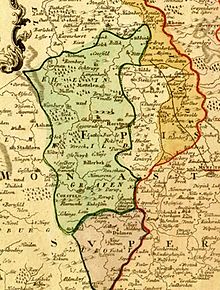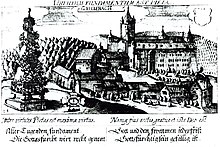Salm-Horstmar
The Lordship of Horstmar was a medieval territory in the Münsterland and fell to the bishopric of Münster in 1269 . This resulted in the Horstmar office , which lasted until the end of the old empire . In the course of the Reichsdeputationshauptschluss 1802/3 it fell to a line of the Salm family . As the county of Salm-Horstmar , the area was an independent territory until it was incorporated into the Grand Duchy of Berg in 1806. After the Congress of Vienna (1815), the area became part of Prussia as a civil lordship .
Early history
The Lordship of Horstmar was a medieval territory and was the seat of the Lords of Horstmar. The noble owners of Horstmar Castle called themselves von Horstmar from 1092. These were probably vassals of the Counts of Cappenberg .
The bishops of Munster had in the area of Coesfeld and Billerbeck in some cases numerous possessions and rights since Liudger's time . The cathedral chapter also owned there. The Counts of Cappenberg equipped the Varlar monastery with their property in the area in 1123 . The monastery could not prevail against the bishops and Coesfeld was already an episcopal city in 1197. The bishops gave the Hastehausen free court as a fief to the Lords of Horstmar.
After the end of the male line, Horstmar came to the Counts of Rietberg through an heir . However, these had to recognize the suzerainty of the bishops of Münster. By purchase, the rule fell directly to the bishopric of Münster in 1269.
The Horstmar Office emerged from the Münster possessions. The Steinfurt lordship was not one of them . A considerable part of the Horstmar office came as a fief to the Counts of Ravensberg and through them as an after fief in the 14th century to the Lords of Merveldt .
Salm-Horstmar
The Reichsdeputationshauptschluss decided, among other things , to use dominant areas in the western part of the secularized Hochstift Münster to compensate imperial estates on the left bank of the Rhine , whose territories had fallen to France. Much of the Münster Office Horstmar so fell to the game and Rhinegrave to Salm -Grumbach whose original seat, the castle Grumbach was. A smaller part went to Prussia.
The counts took possession of the rule at the end of 1802. The final allocation of the property took place in March 1803. The parts of the former office were also joined by the properties of the abolished monasteries or monasteries Asbeck , Metelen , Langenhorst , Borghorst and Varlar . The center of the county was Coesfeld. The residence was the Varlar Monastery, which was converted into a castle .
The counts called themselves Salm-Horstmar after the new property. Wilhelmine Friederike von Salm-Grumbach held the reign for the minor Friedrich Karl August .
With the French occupation and incorporation into the new Grand Duchy of Berg (1806), the direct imperial rule ended. The area belonged to the Arrondissement of Steinfurt from 1806 to 1808 and to the Arrondissement of Coesfeld from 1808 to 1811 . After that, the area came to the right under French rule related department lip .
The territory covered in 1803 the Office Coesfeld, the Office Metelen , the City Court Coesfeld, the City Court Horstmar , the City Court Metelen, the court Billerbeck, the court Gronau , the Gogericht Rüschau , the court Nienborg , the court Rorup and the court Limbergen. The area was about 42.5 square miles and had about 50,000 residents.
family members
- Friedrich (Salm-Horstmar) (* 1799; † 1865), since 1816 Prince of Salm-Horstmar
- Karl zu Salm-Horstmar (* 1830; † 1909), German prince and politician
- Otto I. zu Salm-Horstmar (* 1833; † 1892), German nobleman and right-wing politician
- Eduard zu Salm-Horstmar (* 1841; † 1923), large landowner in Münsterland
- Otto II zu Salm-Horstmar (* 1867, † 1941), German nobleman and right-wing politician
Rulership
In 1816 the area was converted into a civil status within Prussia. The counts were elevated to the Prussian prince's status in 1817. In 1820 Friedrich Karl August took over the property and made a particular effort to promote agriculture and forestry. He was succeeded by his son Otto Friedrich Karl in 1865 . He was followed in 1892 by Otto Adalbert August . The princes were hereditary members of the Prussian manor house . The last remaining privileges as a registrar were abolished in 1920 by the Free State of Prussia .
literature
- Alfred Bruns: Principality of Salm-Horstmar In: Gerhard Taddey: Lexicon of German History , Stuttgart, 1998, p. 1104 f. ( Digitized version )
- Gerhard Köbler : Historical lexicon of the German countries. The German territories from the Middle Ages to the present. 7th, completely revised edition. CH Beck, Munich 2007, ISBN 978-3-406-54986-1 , p. 302, p. 605.
- Wilhelm Kohl : The Diocese of Münster: The Diocese 4. , Berlin, New York, 2004 (Germania Sacra NF 37.4), p. 231 ff.
- Wilhelm Kohl: The Diocese of Münster: The Diocese 1. , Berlin, New York, 1999 (Germania Sacra NF 37.7), pp. 573-576.
Archival material
- Archives of Fst. Salm-Horstmar can be found among others. a. in the State Archive of North Rhine-Westphalia , Dept. Westphalia, z. B. Population list of the parish of Dingden under "Fürstl. Salm'sche Kanzlei", 1806 (Sign. III, 9). Accordingly, these rulers already called themselves "Prince" in 1806.



